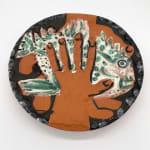Pablo Picasso
Further images
Pablo Picasso's foray into ceramics in the postwar period marked a significant shift in his artistic practice, bridging modernist innovation with the ancestral techniques of the Mediterranean. From the late 1940s, Picasso worked closely with the Madoura Atelier in Vallauris, a historic pottery center in the South of France, under the guidance of Georges and Suzanne Ramié. This period of his career was characterized by an embrace of earthen materials, an interest in the tactility of clay, and a revival of Greco-Roman traditions, which had long permeated the region’s artistic and cultural history. His engagement with ceramics was not merely decorative but deeply sculptural and narrative-driven, allowing him to explore form, texture, and figuration in ways that diverged from his work on canvas. Mains au poisson (1953) belongs to this prolific era, encapsulating Picasso’s fascination with the themes of nature, human interaction, and the quotidian rituals of Mediterranean life.
The composition of Mains au poisson is striking in its directness and dynamism. The piece presents a pair of hands grasping a fish, rendered in earthy terracotta tones with expressive black, green, and white accents. The use of raw clay as a base reinforces a sense of immediacy and materiality, evoking ancient ceramic traditions while maintaining a thoroughly modern visual language. The hands, central to the composition, emerge almost sculpturally from the surface, their presence both firm and protective. The fish, painted with loose, gestural strokes, exudes movement and vitality, its scales and fins imbued with a rhythmic, almost musical quality. The contrast between the smooth areas of the ceramic and the heavily textured details heightens the expressive tension in the work, suggesting not just the physical grasping of the fish but also an allusion to the eternal relationship between humans and nature, survival, and sustenance.
Beyond its formal qualities, Mains au poisson is a poetic reflection on the cultural and culinary heritage of the Mediterranean. Fishing, a livelihood deeply rooted in the region, is here transformed into a timeless, symbolic gesture—one that speaks of nourishment, tradition, and the intimate connection between human hands and the natural world. The motif of hands in Picasso’s ceramics often carried multiple meanings: they could signify creation, possession, or even a spiritual offering. In this piece, the hands seem to simultaneously cradle and present the fish, as if caught in a moment between acquisition and gift-giving, reinforcing the idea of communal life and shared meals intrinsic to Mediterranean customs. With its raw energy, painterly approach to ceramic decoration, and a subject deeply embedded in the cultural landscape of the South of France, Mains au poisson stands as a testament to Picasso’s ability to merge past and present, the archaic and the avant-garde, into a singular, powerful vision.










